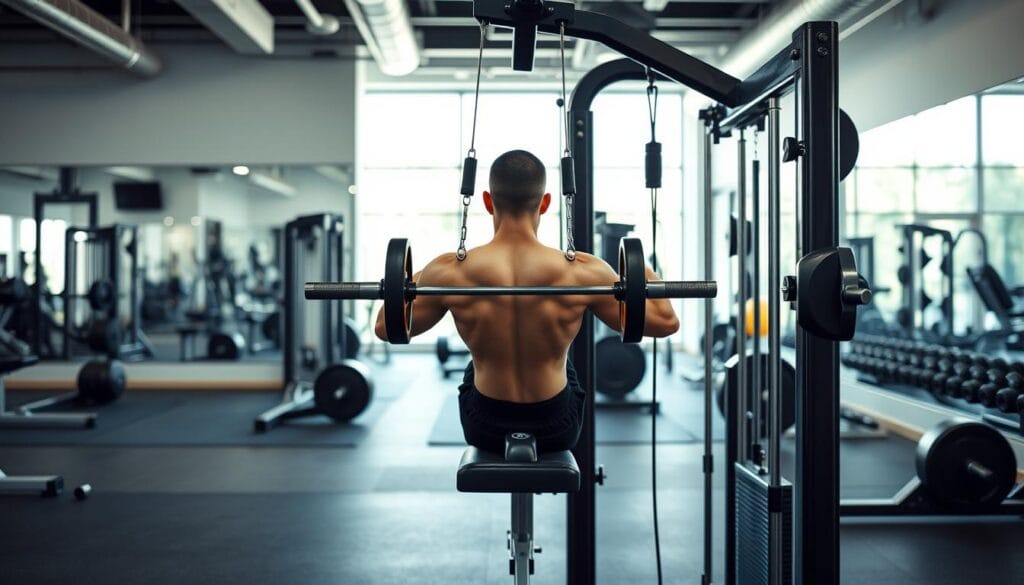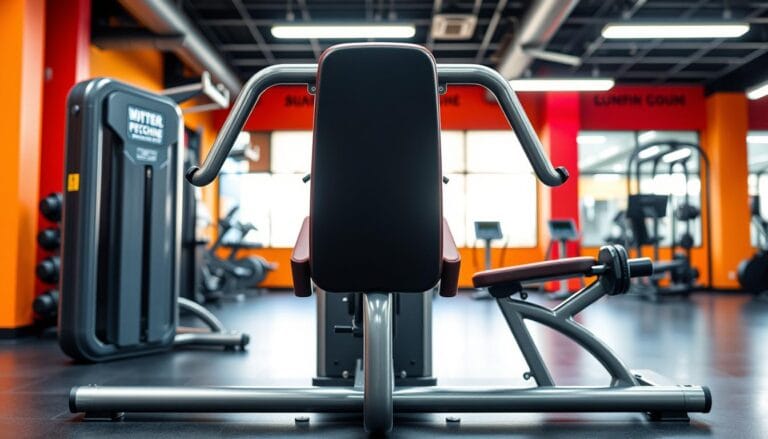Best Cable Back Exercises for Strength
Cable back exercises are a game-changer for building strength and muscle. Unlike free weights, cable machines offer constant tension. This challenges your muscles from start to finish.
These exercises are great for targeted muscle growth and better back strength. When you add cable back exercises to your routine, you get a powerful way to build a stronger body. Cable machines let you focus on specific muscles, making them key for back training.
Table of Contents
Understanding Back Muscle Anatomy and Function
Your back is made up of many muscles that help you move and stay stable. To get a strong back, it’s important to know about the muscles involved in cable pulls.
The human back has an amazing 40 muscles. Each muscle group has its own job in helping your body move and stay upright. Let’s look at the main muscle groups that make up your back’s strength.
Upper and Lower Trapezius
The trapezius muscle is shaped like a V, running from your neck to your lower back. It has three main parts:
- Upper trapezius: Helps lift your neck and shoulders
- Middle trapezius: Helps pull your scapula back
- Lower trapezius: Supports moving your scapula down
Latissimus Dorsi
Your latissimus dorsi, or lats, are the biggest muscles in your upper back. They are key in arm extension and shoulder rotation during back workouts.
| Muscle Group | Primary Function | Role in Back Workout |
|---|---|---|
| Latissimus Dorsi | Arm Extension | Primary Pulling Movement |
| Trapezius | Shoulder Movement | Stabilization |
Rhomboids and Erector Spinae
The rhomboids help pull your scapula back, keeping your shoulder blades stable during exercises. The erector spinae muscles, including the spinalis, longissimus, and iliocostalis, keep your spine straight and support your posture during tough workouts.
“Understanding your back muscles is the first step to developing a powerful, injury-resistant physique.” – Strength Training Expert
Knowing about these muscle groups helps you create better cable pulls for your back. This targets specific muscles, builds balanced strength, and lowers injury risks.
Benefits of Training Back with Cable Machines
Cable back workouts bring unique benefits to your strength training. Unlike free weights, cable machines offer constant tension. This helps in developing muscles better.
Here are the main advantages of adding cable pull back exercises to your routine:
- Constant muscle tension for enhanced muscle growth
- Improved muscle isolation and targeting
- Reduced risk of injury compared to free weights
- Enhanced flexibility in exercise variations
A study in the Journal of Strength & Conditioning Research found cable back workouts are very beneficial. It showed that 16 weeks of these exercises can greatly reduce back pain.
“Cable machines allow you to maintain smooth, controlled movements that traditional weights cannot replicate.” – Fitness Research Institute
| Exercise | Primary Muscle Group | Key Benefit |
|---|---|---|
| Seated Cable Row | Mid-back | Improves posture |
| Lat Pulldown | Latissimus Dorsi | Enhances back width |
| Cable Face Pull | Upper Back | Increases shoulder stability |
Using cable machines lets you target back muscles with precision. You can adjust resistance and angle. This makes cable back workouts versatile and effective for building strength and definition.
Essential Equipment and Setup for Cable Back Exercises
To get the most out of cable back workouts, you need the right gear and know how to set it up. The success of your cable rows and lat pulldowns depends on the equipment you choose.
Cable Machine Varieties
Cable machines vary to meet different training needs. You’ll find several main types:
- Standalone cable units
- Multi-functional cable crossover systems
- Wall-mounted cable stations
- Functional trainer machines
Essential Attachments and Accessories
Attachments can greatly enhance your cable back workouts. Here’s a list of key accessories:
| Attachment | Primary Use | Muscle Groups Targeted |
|---|---|---|
| Straight Bar | Wide-grip lat pulldowns | Latissimus dorsi, biceps |
| V-Handle | Cable rows | Rhomboids, trapezius |
| Rope Attachment | Face pulls | Rear delts, rotator cuff |
| Single-Grip Handle | Unilateral exercises | Addressing muscle imbalances |
Setup Guidelines for Optimal Performance
Setting up your machine correctly is key for great cable back exercises. Follow these steps:
- Adjust seat height to align with cable attachment point
- Ensure smooth cable movement without friction
- Select appropriate weight for your fitness level
- Position yourself symmetrically
- Maintain proper grip width for targeted muscles
“The right setup transforms an average workout into an exceptional muscle-building session.”
Knowing your equipment and mastering setup techniques will unlock the full potential of cable rows and lat pulldowns. This will make your back training more effective and safer.
Cable Back Exercises for Building Strength
Cable machines offer a special way to work out your back. They keep your muscles tight and offer different levels of resistance. Adding these exercises to your routine will make your back muscles stronger and more defined.
Here are the top cable back exercises for building strength and muscle:
- Seated Cable Rows: A key exercise for your mid-back muscles
- Straight-Arm Pulldowns: Great for your latissimus dorsi
- Lat Pulldowns: Ideal for widening your back
- Face Pulls: Good for your shoulders and upper back
Seated cable rows are especially good for strengthening your back. They help you focus on pulling your shoulders back without straining your lower back. Make sure to keep the right form and control your movements while doing seated cable rows.
| Exercise | Primary Muscles Targeted | Recommended Sets/Reps |
|---|---|---|
| Seated Cable Rows | Rhomboids, Latissimus Dorsi | 3-4 sets of 10-15 reps |
| Straight-Arm Pulldowns | Latissimus Dorsi | 3 sets of 12-15 reps |
| Lat Pulldowns | Latissimus Dorsi, Upper Back | 3-4 sets of 8-12 reps |
“Consistency and proper form are key to maximizing your cable back workout effectiveness.” – Strength Training Professionals
For the best results with straight-arm pulldowns, focus on smooth movements. This exercise targets your lats and keeps your muscles engaged. Start with lighter weights to get the hang of it, then increase the weight as you get better.
Cable exercises are safer than free weights because they focus on specific muscles. As you get better at these exercises, your back will get stronger. This will help you achieve a more toned and powerful body.
Mastering Proper Form and Technique
Getting your technique right is key when doing cable back exercises. Back pain affects 80% of people at some time. Knowing the right form is vital for building muscles and avoiding injuries.
Doing back exercises with cables is more than just lifting weights. How you do it affects which muscles you work and how well you work out.
Common Form Mistakes to Avoid
- Using momentum instead of muscle power
- Neglecting core engagement
- Improper spine alignment
- Failing to maintain consistent tension
Maximizing Muscle Activation
To get the most from cable back exercises, focus on these critical techniques:
- Squeeze shoulder blades during each movement
- Maintain a neutral spine position
- Control weight throughout entire range of motion
- Engage core muscles consistently
Breathing Patterns for Optimal Performance
Proper breathing can boost muscle engagement by up to 25%. Here’s a recommended breathing technique:
| Exercise Phase | Breathing Recommendation |
|---|---|
| Concentric (Lifting) | Exhale |
| Eccentric (Lowering) | Inhale |
“Precision in technique transforms ordinary movements into powerful muscle-building opportunities.”
Remember, mastering form in cable back exercises reduces injury risk by up to 50% while maximizing muscle development potential.
Creating an Effective Cable Back Workout
To make a great cable back workout, you need a good plan and know which muscles to target. Cable machines are great for back exercises. They offer constant tension and different movements that free weights can’t.

- Target multiple back muscle groups
- Balance vertical and horizontal pulling movements
- Incorporate unilateral and bilateral exercises
- Progressively increase resistance
A good cable back workout should hit different back muscles. Studies show doing 10-15 reps for 3 sets helps grow muscles and get stronger.
“The key to an effective back workout is variety and consistent muscle engagement.” – Strength Training Expert
Here’s a sample cable back workout structure:
- Lat Pulldowns: 3 sets of 12 reps
- Single-Arm Cable Rows: 3 sets of 10 reps per side
- Cable Face Pulls: 3 sets of 15 reps
- Straight Arm Pulldowns: 3 sets of 12 reps
Cable back workouts have special benefits like constant tension and less injury risk. Choose the right exercises and keep proper form. This way, you’ll build a strong, defined back.
Progressive Overload and Training Variables
To get better at cable pulls for back, you need a smart plan. Progressive overload is key for muscle growth and strength. By pushing your muscles harder, you’ll see steady gains in your workouts.
Weight Selection Guidelines
Picking the right weight is vital for cable back exercises. Here are some tips:
- Start with a weight that lets you keep perfect form
- Try to add 2-3% more weight each week
- Use the Rate of Perceived Exertion (RPE) scale to check how hard you’re working
Set and Rep Schemes
Choose the best rep ranges for cable back training:
- Strength Focus: 1-6 reps, 3-6 sets
- Muscle Growth: 8-12 reps, 3-4 sets
- Endurance: 12-15 reps, 2-3 sets
Rest Periods
Rest times are crucial for muscle recovery and growth. Smart rest can also be a form of progressive overload:
- Strength training: 2-3 minutes between sets
- Hypertrophy: 60-90 seconds rest
- Slowly cut down rest times to boost workout intensity
“Progressive overload is not just about lifting more weight, but about challenging your muscles in smart, incremental ways.”
Keep in mind, your progress can vary based on genetics, age, and experience. Staying consistent, focusing on form, and gradually increasing the challenge are essential for the best results in your cable back workouts.
Advanced Cable Training Techniques and Variations
To take your cable back workouts to the next level, you need advanced techniques. These methods challenge your muscles and prevent plateaus. Cable rows and lat pulldowns are great for creating new training approaches.

Professional lifters use several powerful methods to grow muscle and increase strength:
- Drop Sets: Decrease weight progressively to extend muscle fatigue
- Unilateral Exercises: Target muscle imbalances with single-arm movements
- Superset Techniques: Pair complementary cable back exercises for increased intensity
Specialized cable training techniques can greatly improve your workouts. Using variations like single-arm cable rows helps balance muscle strength. It keeps the resistance consistent.
“Advanced cable techniques transform standard workouts into dynamic muscle-building experiences”
| Technique | Muscle Impact | Difficulty Level |
|---|---|---|
| Unilateral Lat Pulldowns | Targeted Lat Engagement | Intermediate |
| Drop Set Cable Rows | Muscle Fatigue Optimization | Advanced |
| Pause-Rep Cable Pulldowns | Time Under Tension | Intermediate |
By using these advanced techniques, you’ll keep challenging your muscles. You’ll break through plateaus and achieve better strength.
Conclusion
Your journey with cable back exercises is a smart way to build muscle strength and shape. Cable exercises have special benefits compared to free weights. They keep your muscles working hard from start to finish, helping them grow stronger.
To get the most out of cable back exercises, focus on doing them right and keep getting stronger. By doing them 2-3 times a week, you’ll build a stronger, more defined back. This way, you also lower the chance of getting hurt.
Success in fitness comes from being consistent and careful in your training. Make sure your cable exercises are done slowly and with control. This helps your muscles work together and keeps the tension steady. It doesn’t matter if you use one or two machines; what’s important is pushing yourself and keeping your form perfect.
Your fitness journey is unique and powerful. Use the flexibility of cable machines to your advantage. Listen to your body and stay true to your strength goals. With time and effort, you’ll see big improvements in your back strength and overall look through these effective exercises.







